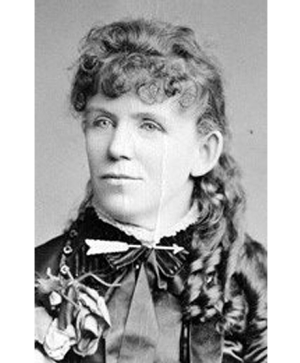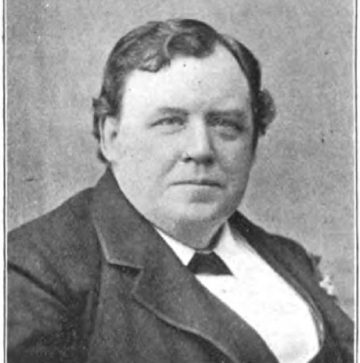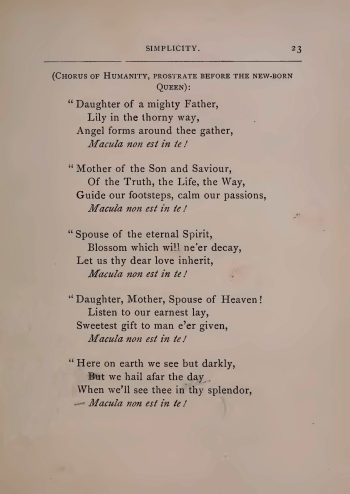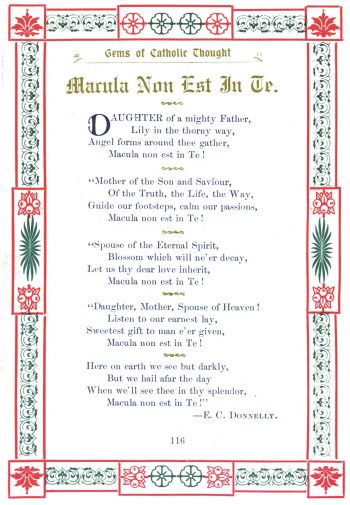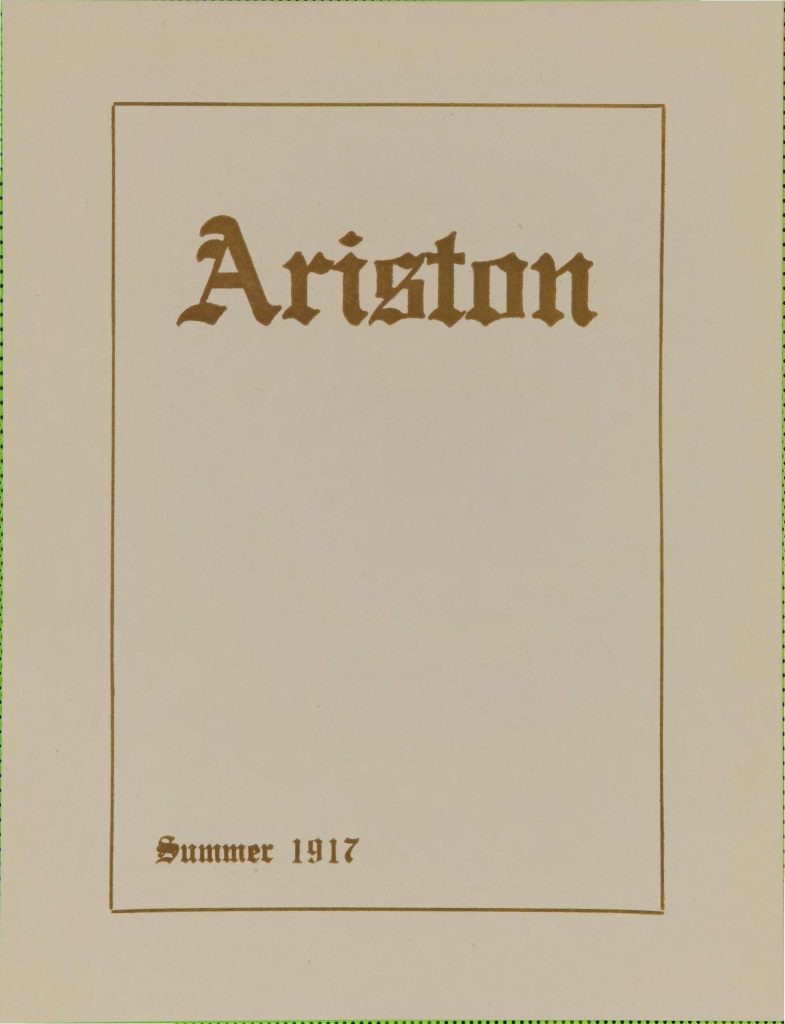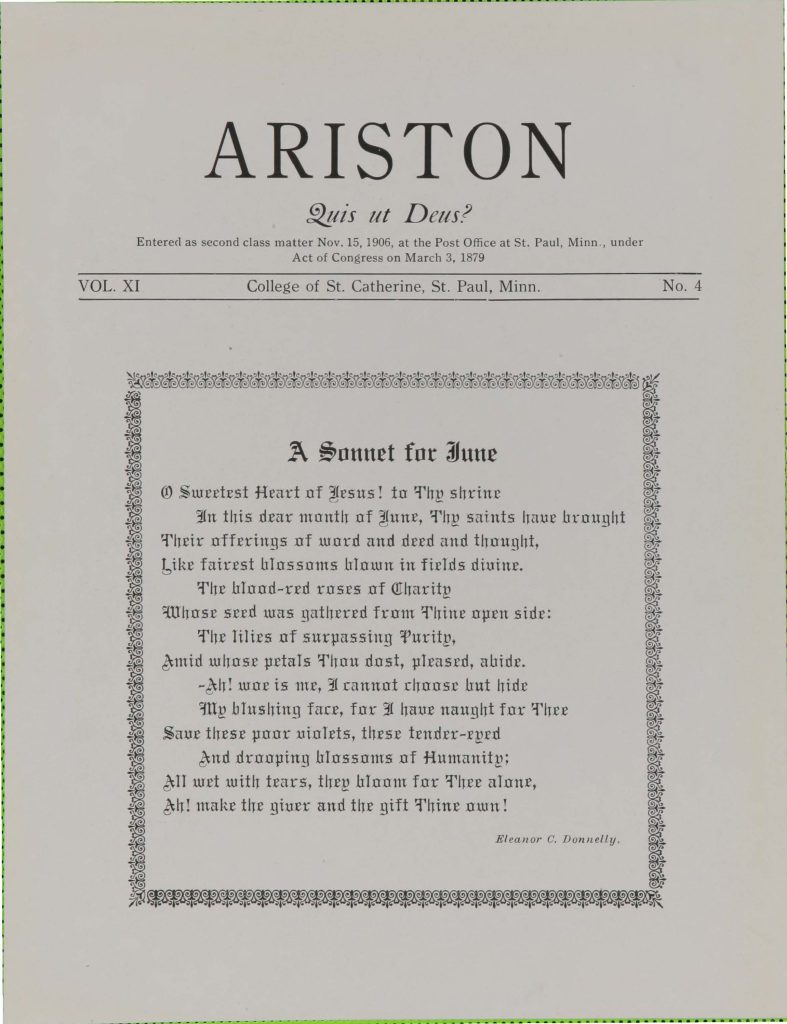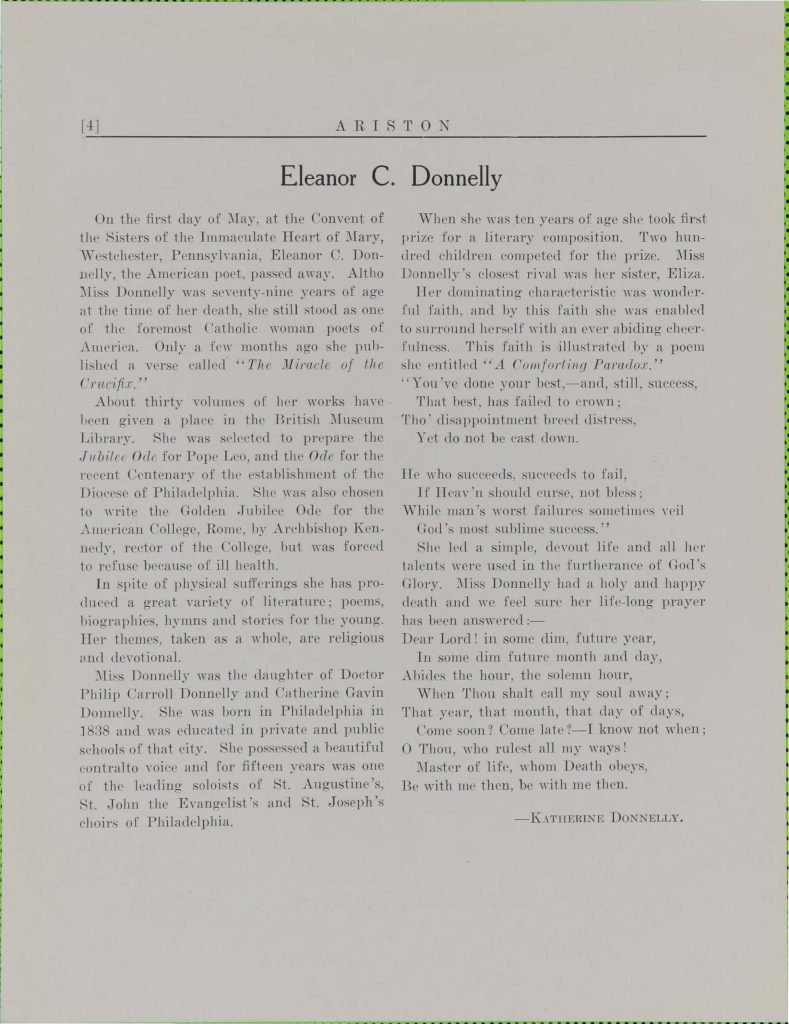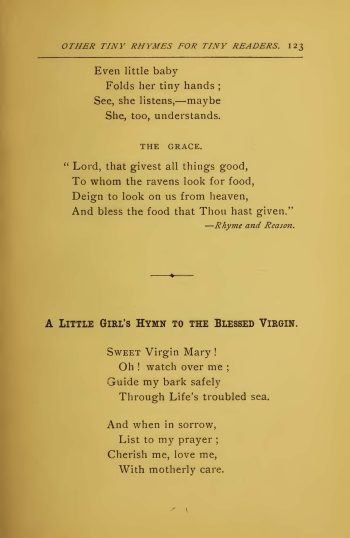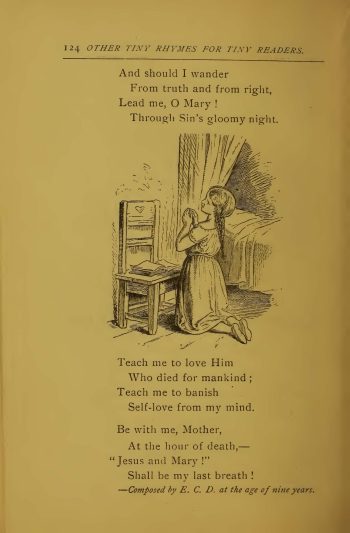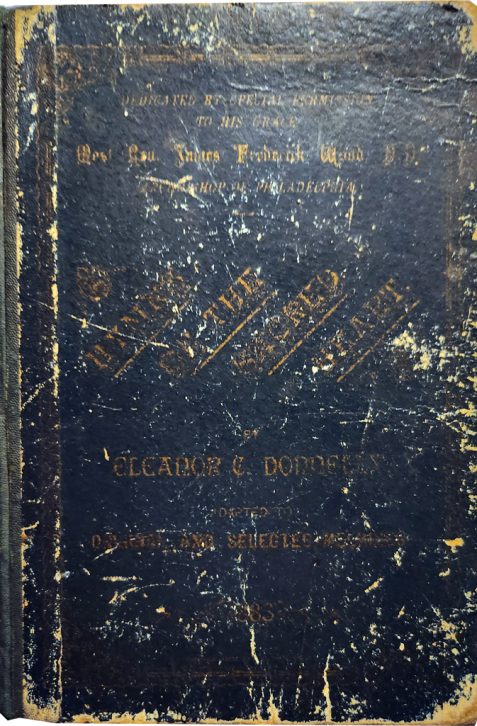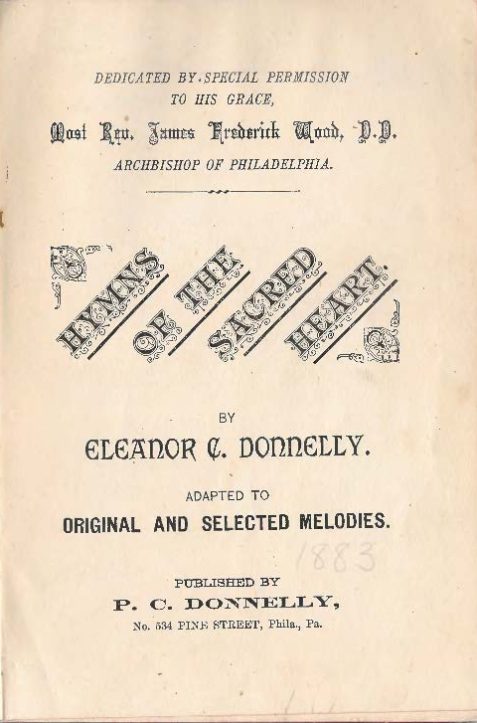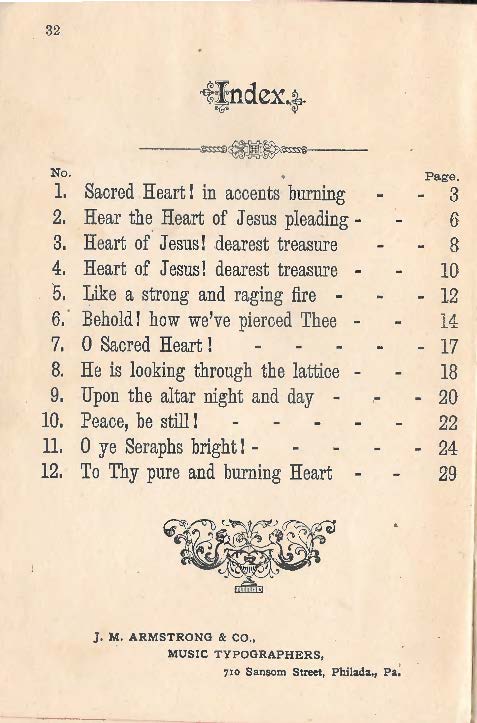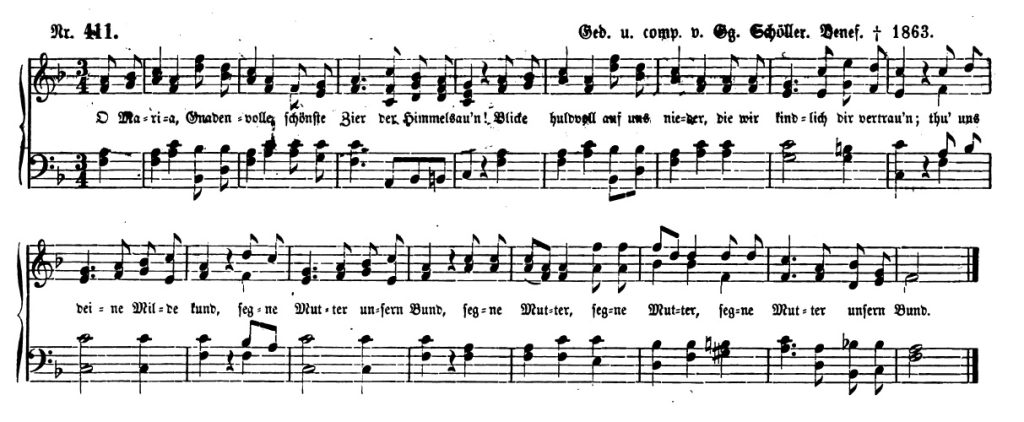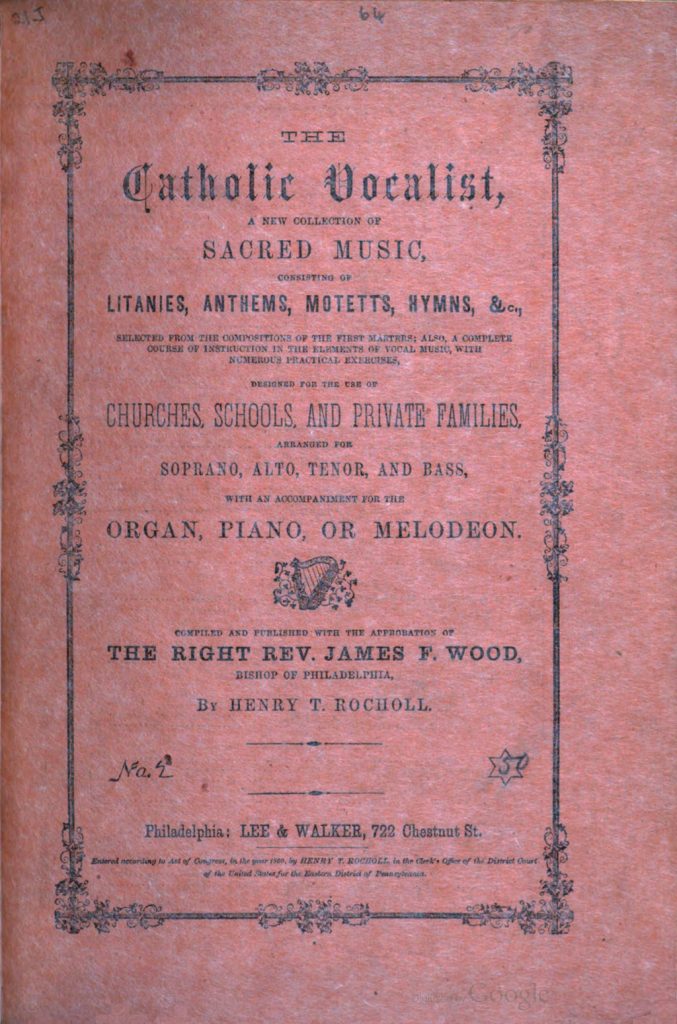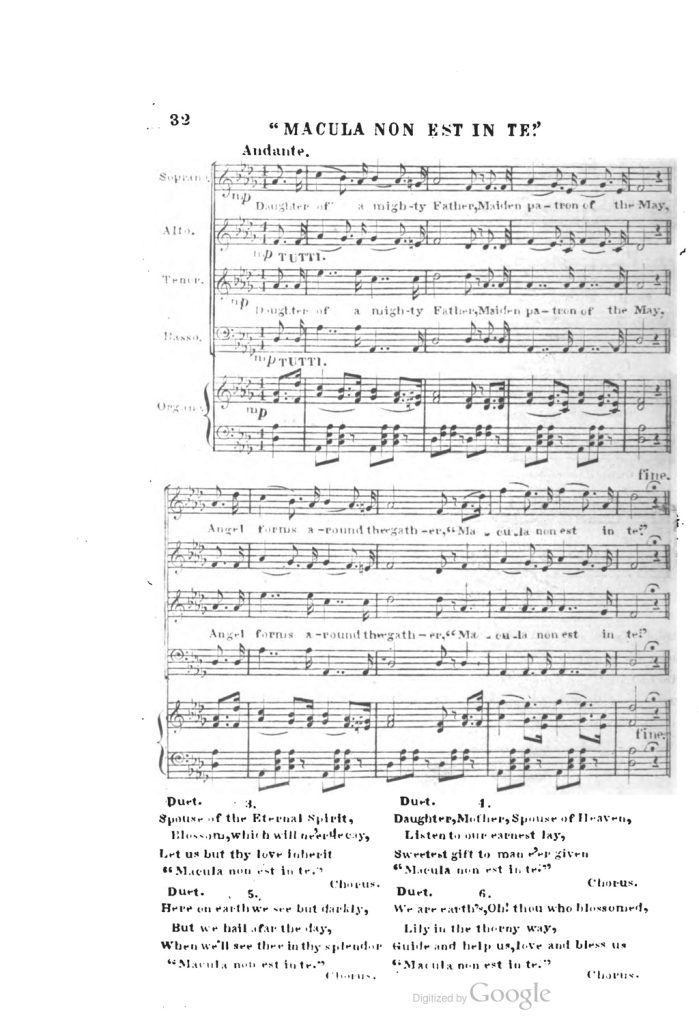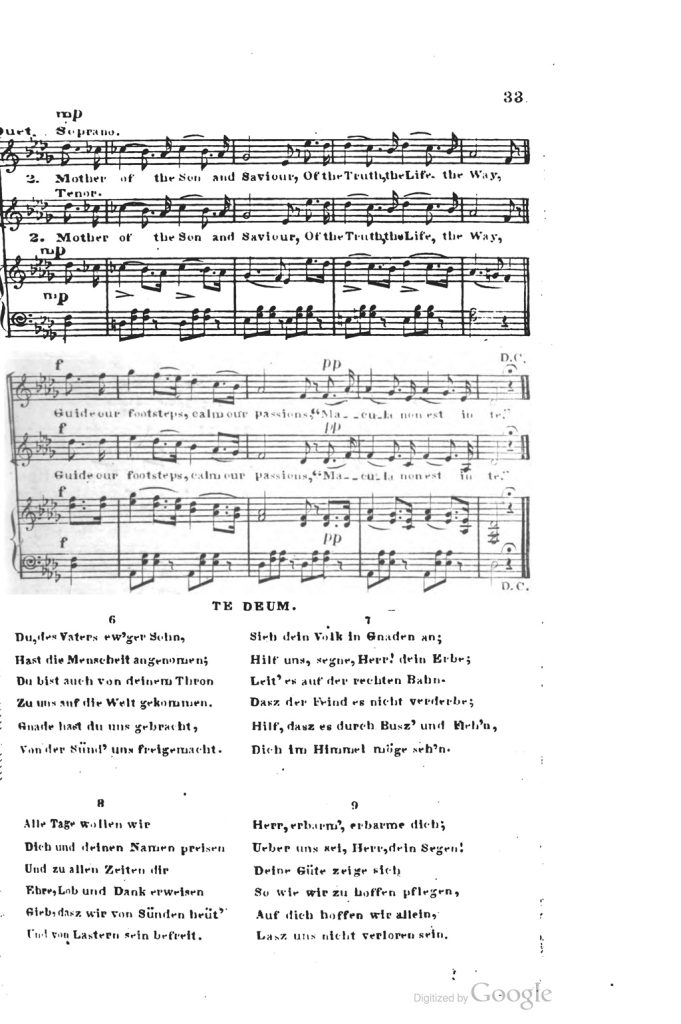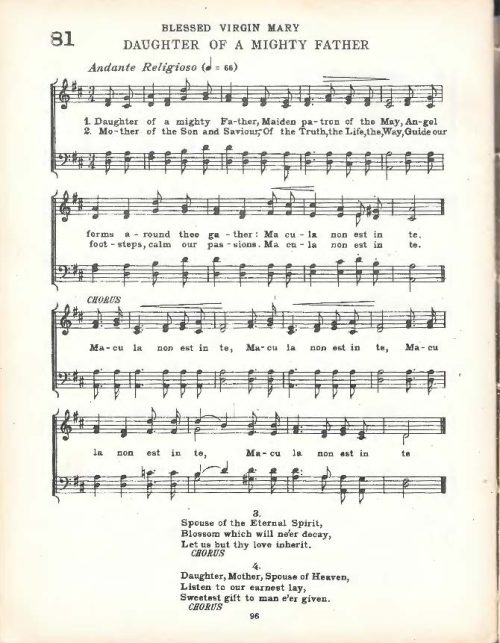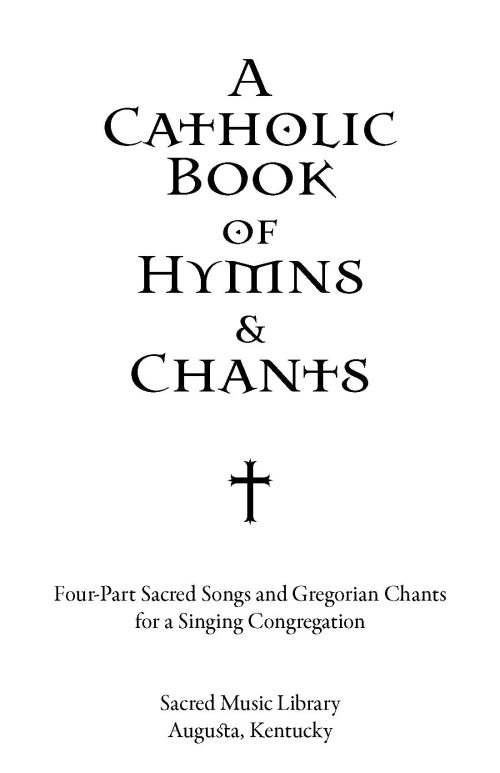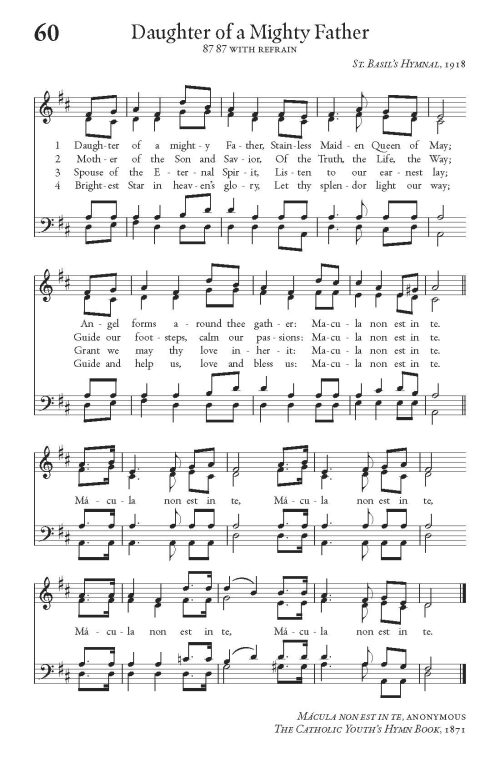Eleanor Cecilia Donnelly (1838-1917) is the author of this hymn. Eleanor began to write poetry at an early age. Her older brother, the Honorable Ignatius Donnelly, former Lieutenant-Governor of Minnesota, and an author in his own right, taught Eleanor the mysteries of meter. On page 352 of the 1917 June issue of The Catholic World a monthly magazine published by the Paulist Fathers is a memorial to Eleanor Donnelly written by Father Thomas M. Schwertner, O.P., S.T.L., (1883-1934) within this memorial is an anecdote in Eleanor’s own words that recounts being taught by her older brother. She herself, speaking of her childhood, relates how she used to go to her brother’s study to be trained in the occult mysteries of poetic meter. What can a child of eight or ten know of prosody or poetic feet? Yet I have a distinct remembrance of standing—a tiny girl—by Ignatius’ writing table, and of being shown by him with great kindness and patience how to reckon on my fingers the correct number of syllables in a given line.
I found two sources which show that Eleanor is the author. The first source is from her own collection of poems CROWNED WITH STARS published by Notre Dame University of Indiana in 1881. This collection of poems was published to aid in placing on the dome of the new University of Notre Dame, Indiana, a colossal statue of the Blessed Virgin Mary, crowned with twelve stars of electric light.
There are twelve poems that Eleanor wrote for each star in the crown, and each was given a particular virtue. Purity, Simplicity, Generosity, Recollection, Humility, Fraternal Charity, Poverty, Obedience, Detachment, Fidelity, Self-Immolation, Divine Love and Eternal Union with God. The statue of Our Lady atop the dome is over eighteen feet tall and both statue and dome are gilded in gold. The poem was for the second star – Simplicity.
The second source is GEMS OF CATHOLIC THOUGHT, a collection of poetry and prose by various Catholic authors which was published by the Redemptorist Fathers of Boston, Massachusetts in 1908.
There are other accounts indicating that she started writing poetry at an early age. One such account says she was a young girl of eight or nine when she wrote a hymn to the Blessed Mother. In an article that appeared in the 1917 summer issue of ARISTON, published every quarter by the College of St. Catherine in St. Paul, Minnesota, there is a brief memorial to Eleanor Donnelly and a passage that reads, When she was ten years of age, she took first prize for a literary composition. Two hundred children competed for the prize. Miss Donnelly’s closet rival was her sister, Eliza.
After a careful review of her many works of poetry which are available online, I found the hymn she wrote as a little girl in her book of poetry Little Compliments of the Season and other Tiny Rhymes for Tiny Readers published by Benziger Brothers in 1887. It is captioned A Little Girls Hymn To The Blessed Virgin.
Eleanor was born on September 6, 1838 to Dr. Philip Carroll Donnelly and Catherine Frances (née Gavin) Donnelly. Her father emigrated from Ireland, settled in Philadelphia, and married Catherine Frances Gavin. For a time he was a traveling salesman of small dry goods and later owned a pawnshop. He studied medicine in the 1830s at the Jefferson Medical College in Philadelphia and received his medical degree in 1839. Her father became a distinguished physician, and he held a number of important positions in and about Philadelphia and was one of the founders of the Philadelphia College of Medicine. He came down with typhus after treating a patient and died a few years after Eleanor was born. Her mother was an exceptional woman faith who continued to operate the pawnshop and saw to the education of the children.
Eleanor had four older siblings: Sarah T. Donnelly, her oldest sister, and Eliza; her older brothers John G., and Ignatius Donnelly, and her younger sisters: Agnes (Mrs. Samuel Kilpatrick), and Philipanna Donnelly. Agnes was the only one of her sisters who married and had children. The entire family was musically and literary artistic. Sarah, Eliza, and Philipanna were school teachers. Besides being an authoress, Eleanor possessed a beautiful contralto voice and served for fifteen years as the leading soloist at St. Augustine’s, St. John the Evangelist’s, and St. Joseph’s choirs in Philadelphia.
As young woman, Eleanor fell under the influence of Father Edward Sorin, C.S.C., who was the first editor of The Ave Maria, a weekly journal devoted to the Honor of the Blessed Virgin which he first published in 1865. Eleanor was a regular contributor to The Ave Maria and helped to enlist other men and women in the field of Catholic literature to contribute. The Ave Maria grew quickly, and by the turn of the twentieth century, it had become the most popular Catholic magazine in the world. The magazine was published on Sundays until 1970. Today The Ave Maria is known as Ave Maria Press.
She also contributed to the success of other Catholic periodicals including: The Messenger of the Sacred Heart; Nova et Vetera, a homiletic magazine for the clergy. She was for a time chief editor of the magazine, Our Lady of Good Counsel, conducted by the Augustinian Fathers. In The Catholic Standard and Times, a Catholic weekly of Philadelphia with which she was connected for some time as associate editor, much of her work appeared, even as late as a month before her death. She was also a very devoted member of the American Catholic Historical Society, and the author of the Memoir of Father Felix J. Barbelin, S.J., founder of the Sodality of the Blessed Virgin Mary in Philadelphia, and the Life of Sister Mary Gonzaga Grace of the Daughters of Charity of St. Vincent De Paul.
She published a collection of hymns in Honor of the Sacred Heart of Jesus in 1883 and the again in 1912. In this rare hymnal several other hymns can be found which later became popular: Sacred Heart, In Accents Burning; Hear the Heart of Jesus Pleading; and Like a Strong and Raging Fire. Eleanor Donnelly is one of the very few American Catholic hymn writers besides Father Jeremiah Cummings who published volumes of original hymns.
In addition to her Sacred Heart collection, Eleanor is the author of the following hymns:
- Behold the Month of Mary – found in the Sacred Wreath, 1863
- Glorious Mother, from High Heaven – found in the Catholic Youth’s Hymn Book, 1871
- Mary, Dearest of All Mothers – found the Manual of Select Catholic Hymns and Devotions, 1925
- O Virgin Mother, Our Lady of Good Counsel – found in Our Lady of Mercy Hymnal, 1899
- ‘Tis the Month of Our Mother – found in St. Basil’s Hymnal, 1918
- Vision of the Wounds – found in the Sunday School Hymn Book, 1887
Eleanor died between April 30 and May 1, 1917 during the feast of St. Catherine of Siena, whose name she had taken upon entering the Third Order of St. Dominic (Lay Fraternities of Saint Dominic or Lay Dominicans since 1972). She spent her last days in West Chester, Pennsylvania among the Sisters of the Immaculate Heart of Mary with whom she was affectionally dedicated to. She was clothed in the Dominican habit and her Requiem Mass was attended by relatives, scores of priests and religious, and thousands of admirers. Before and after the mass her own hymns to the Sacred Heart were sung by the novices of the Community and the boys from St. Aloysius’ Academy.
She published some fifty volumes of poetry and prose most of it from a Catholic perspective. Some thirty volumes were given a place in the British Museum Library. Her poetry influenced the minds and hearts of other great poets such as Longfellow, Wordsworth, and Tennyson. She was often compared to Adelaide Procter — Queen Victoria’s favorite poet, and of her religious poems which could be described as sacred hymns, she stands next to Father Frederick Faber.
It is difficult to encompass the whole spectrum of Eleanor Donnelly’s poetical output. Hopefully, this small tribute to her will be enough to encourage others to explore her many books of poetry and prose, and who knows what gems may be waiting for the Catholic composers pen.
The earliest appearance of the hymn is found in THE CATHOLIC VOCALIST, 1860 compiled by Henry T. Rocholl and captioned Macula non est in te. THE CATHOLIC VOCALIST was a small periodical of sacred music consisting of litanies, anthems, motets, and hymns for churches, schools, and private families. This collection of sacred music highlights Marian hymns from THE SACRED WREATH. The hymn generally appears in hymnal index’s as Daughter of a Mighty Father but has also been found in some hymnals as Macula non est in te or indexed under both titles.
The next appearance of the hymn is found in THE SACRED WREATH, 1863, a collection of hymns for the use of the Sodality of the Blessed Virgin Mary. The Sodality of the Blessed Virgin Mary is the oldest sodality in the United States and was first established in Philadelphia in 1841 by Father Felix Barbelin, S.J., he prepared the first Manual for the Sodality. This Manual contained the Office of The Blessed Virgin, the Office for the Dead, the origin and rules of the sodality, and various prayers.
This Sodality gradually developed a collection of hymns, THE SACRED WREATH. The hymns began as a small private collection that was published in the early 1850’s and eventually was followed by a second edition in 1863, and a third in 1881. The third edition contains over three hundred pages of hymns. The hymnal was compiled by Father Edward J. Sorin (1808-1888), and Father Felix Barbelin, S.J., (1808-1869) and published in Philadelphia by Eugene Cummiskey. The Sodality of the Blessed Virgin Mary was originally approved by Pope Gregory XIII in 1584. Copies of THE SACRED WREATH are exceedingly rare today.
The hymn also appeared in the following Catholic hymnals:
The CATHOLIC YOUTH’S HYMN BOOK, 1871 compiled by the Christian Brothers of New York; the ST. BASIL’S HYMNAL, 1888 thru 1953, compiled by the Basilian Fathers of Toronto; the MANUAL OF THE SODALITY OF THE BLESSED VIRGIN MARY, 1893 published by H. L. Kilner & Co.; the CATHOLIC SCHOOL AND SODALITY MANUAL, 1900 published by George W. Gibbons of Philadelphia; the CROWN HYMNAL, 1913 compiled by Father L. J. Kavanagh & James McLaughlin and published by Ginn and Co.; the DE LA SALLE HYMNAL, 1913 compiled by the Brothers of the Christian Schools; the 1921 & 1948 HYMNS USED BY THE PUPILS OF THE SISTERS OF NOTRE DAME; SELECTED HYMNS, 1930 published by Angel Guardian Press; the CATHOLIC SCHOOL HYMNAL, 1930 compiled by Joseph P. Donnelly and published by Emil Ascher Inc.; a CATHOLIC HYMN BOOK, 1932 published by The Paulist Press; a MANUAL OF HYMNS FOR THE CATHOLIC SCHOOL, 1948 published by The Voshardt Press; editions of CATHOLIC CHAPEL HYMNAL, 1944 thru 1968 published by McLaughlin and Reilly; and A CATHOLIC BOOK OF HYMNS, 2020 published by the Sacred Music Library in Kentucky.
Many of the hymnals listed above are available for download at the Corpus Christi Watershed website.
Melodies
The melody traditional to Daughter of a Mighty Father is found in the ENGELSHARFE GESANGBUCH, 1866, hymn No. 411, by the composer Father Georg Schöller for the hymn O Maria, Gnadenvolle (O Mary, Full of Grace). Fr. Schöller was born in 1813 Obernzell, Germany and ordained a Catholic priest in 1836. He never became a pastor, but held small assistant priestly positions, his last post was at Thurnstein Castle near Postmünster in 1854. He remained there until his death in 1863.
Another melody is featured in the periodical mentioned above, THE CATHOLIC VOCALIST, published by Henry T. Rocholl and is based upon Gaetano Donizetti’s (1797-1848) opera Lucrezia Borgia / Act 1, Maffio Orsini, singnora, son io. The opera, one of about seventy by Donizetti, was written in 1835.
Reflection
In Miss Donnelly’s generation, most Catholics read a good deal of poetry, it was part of their everyday life and part of their early education. Early Catholic hymn writers like Miss Donnelly, were well educated in their Catechism and possessed the gift of poetry so much so that they could present these Catholic beliefs in a poetic way. As a result, hymns became more like prayers rather than just poetry. That’s why today we need good Catholic poets to write hymn lyrics instead of musicians who think they are poets!
I learned to sing this hymn using the arrangement from the ST. BASIL’S HYMNAL. This hymnal was one of the most popular and most widely used Catholic hymnals in the United States and Canada. The hymn is a profession of the tenants of Catholic belief regarding Our Lady and her Immaculate Conception. We can see this in the refrain Macula non est in te, which means, there is no stain in thee. The hymn was a favorite among the choir members and parishioners of St. Mary’s. It is a lovely hymn to sing during the month of May or anytime we honor Our Blessed Mother.
Looking back over my long tenure in the choir and the last several years of studying about Catholic hymns, the authors, and composers, I’ve come realize how important it is to have hymn lyrics that profess our Catholic beliefs and how important it is that they present those beliefs in a meaningful way. Hymns like Daughter of a Might Father help to remind me of my Catholic faith and the teachings of the Catholic Church. For example, in St. Mary’s above the High Altar there is a beautiful painted fresco of the Assumption of Our Lady surrounded by angels. I can see this in the phrase, Angel forms around thee gather.
A weekly infusion of devotional hymns during Mass will help to erode away the alarming statistics that there is a failure of Catechism in our Catholic Church. Even though these devotional hymns are from a different time and a different generation, they can still be used in a very efficacious way to instruct children, young adults, men, and women of all ages about our Catholic faith. Take a moment to read the verses and I think you will agree.
A special thank you to Peter Meggison, producer of The Devotional Hymns Project for allowing me to link to a recording of Daughter of a Mighty Father by the Seraphim Singers at Holy Name Church, Boston.
Also, a special thank you to Noel Jones, AAGO in granting permission to link to A Catholic Book of Hymns with nearly 300 time-honored traditional Catholic hymns including Daughter of a Mighty Father.
Below are recordings from The Devotional Hymns Project website featuring the Seraphim Singers, a recording from A Catholic Book of Hymns, and a computer generated sound file of the melody from The Catholic Vocalist.

